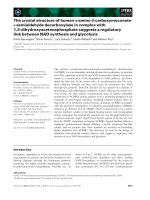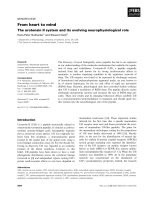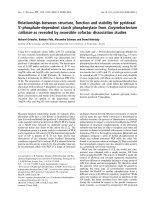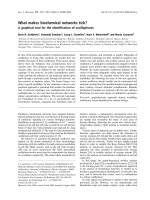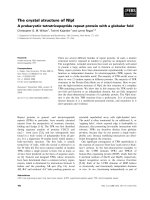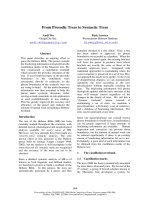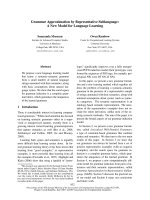Báo cáo khoa học: "From Information Structure to Intonation: A Phonological Interface for Concept-to-Speech" pot
Bạn đang xem bản rút gọn của tài liệu. Xem và tải ngay bản đầy đủ của tài liệu tại đây (459.06 KB, 5 trang )
From Information Structure to Intonation: A Phonological
Interface for Concept-to-Speech
Hannes Pirker, Georg Niklfeld, Johannes Matiasek and Harald Trost +
{hannes,georgn~iohn,harald} ~ai.univie.ac.at
Austrian Research Institute for Artificial Intelligence (OFAI)*
Schotteng. 3, A-1010 Vienna, Austria
+Department of Medical Cybernetics and Artificial Intelligence University of Vienna
Freyung 6, A-1010 Vienna, Austria
Abstract
The paper describes an interface between gen-
erator and synthesizer of the German language
concept-to-speech system VieCtoS. It discusses
phenomena in German intonation that depend
on the interaction between grammatical depen-
dencies (projection of information structure into
syntax) and prosodic context (performance-
related modifications to intonation patterns).
Phonological processing in our system com-
prises segmental as well as suprasegmental di-
mensions such as syllabification, modification of
word stress positions, and a symbolic encoding
of intonation. Phonological phenomena often
touch upon more than one of these dimensions,
so that mutual accessibility of the data struc-
tures on each dimension had to be ensured.
We present a linear representation of the
multidimensional phonological data based on a
straightforward linearization convention, which
suffices to bring this conceptually multilinear
data set under the scope of the well-known pro-
cessing techniques for two-level morphology.
1 Introduction
The task of interfacing between a tactical gen-
erator and a speech synthesizer is two-fold: A
grammatical description enriched with semantic
and pragmatic features has to be translated into
a (qualitative) phonological description which
then has to be mapped onto the set of (quanti-
tative) parameter values needed as input to the
synthesizer.
The requirements imposed by a concept-to-
speech system differ from those on both text
generation and text-to-speech systems. In
* This work has been sponsored by the
Fonds zur
FSrderung der wissenschaftlichen Forschung (FWF),
Grant No. P10822.
text generation the generator produces a se-
quence of abstract descriptions of word forms
which are-either by direct access to a lexicon
or via a morphological component-transformed
into strings of graphemes and output. With
concept-to-speech the task is more complex.
Not only is segmental information influenced
by morphonology and post-lexical rules (cover-
ing, e.g., reduction and assimilation phenom-
ena) but-more important-suprasegmental in-
formation must be provided as well.
Compared to text-to-speech the task is at
the same time easier and more difficult. In-
formation from pragmatic, semantic and syn-
tactic layers are readily available. This elimi-
nates the need to analyze an input text for nec-
essary cues to come up with proper pronunci-
ation and prosody. On the other hand all this
information must be properly accounted for to
come up with an adequate description of the
utterance that-when fed into the synthesizer-
produces high-quality output. In particular,
pragmatic-semantic features must be mapped
onto (abstract) prosodic features.
We employ an extended version of two-level
morphology (Trost 91) for this interface) The
formalism proved to be very well suited for the
task. The various Mmost independent subsys-
tems can be kept conceptually separate result-
ing in good transparency while at the same time
enabling the necessary amount of interaction
between them.
2 A Concept-to-Speech Generation
System
Our concept-to-speech generation system con-
sists of a pipeline of modules (Fig. 1). A text
1The extension regards the fact that the system al-
lows the use of (feature-based) external information-so-
called filters-to restrict the application of two-level rules.
1041
planning component produces sentence plans,
which are fed into the tactical generator.
The implementation basis for the tactical
generator is the FUF (Elhadad 91) system.
FUF is based on the theory of functional unifi-
cation grammar and employs both phrase struc-
ture rules and unification of feature descrip-
tions. Input is a partially specified feature de-
scription which constrains the utterance to be
generated. Output is a fully specified feature
description (in the sense of the particular gram-
mar) subsumed by the input structure, which is
then linearized to yield a sentence.
The tactical generator has two layers. One
is dealing with sentence level generation, pro-
ducing a tree-like description of a sentence, the
leaves of which are lemmata annotated with
morphosyntactic and prosodic features. The
second performs generation at the word level
producing annotated phonological representa-
tions of the inflected word forms which are fed
into the extended 2 two-level phonology compo-
nent applying morphological and phonological
rules to arrive at the representation used as in-
put for speech synthesis.
A distinguishing feature of the grammar used
in the generator is the integration of sentence-
level and word-level processing within the same
formalism.
I Text Planner Ill
I
Tactical Generator
Sentence Level Processing
Word Level Processin~l
iiii!!!il i!i i!i iil i!ii!ii!ii!i!i !ii!i ii iii:~i:i:;:; ~iii:i:i:iii:i!iiii!ii;ii!iiii:iiii!ii!i:iiiiiiiii ili!ii
ill Phonology Component ~iliil
!~:: i ::: :: :: ::: :.: :::;:::: ~: ::: ::: :;: ::: :.: :.: :.: ~:~:; :~ :;: :;::;:.:: ~: :~: :~: :i: :i: :; :: :i: :::::: ::!:!
I Speech S~'nthesis /
Figure 1: Architecture
This architecture forms an ideal platform for
the implementation of the phonological inter-
face. Necessary adaptions are limited to the
data used: An existing grammar was extended
with features describing the information struc-
ture. The lexicon consists of entries in phonemic
form (using SAMPA notation) enriched with in-
2The filter handling uses the FUF formalism and the
same ratification machinery as the grammar.
formation like (potential) accent and syllable
boundary positions.
Input to the synthesizer is a SAMPA string
enriched with qualitative encodings of prosodic
information (e.g., pitch accent, pauses, ) pro-
duced by the two-level rules. Phonological spec-
ifications of intonation are processed by a pho-
netic interpreter (Pirker et al. 97) that trans-
forms these qualitative labels into quantitative
acoustic parameters. Although some interpreta-
tive work is done within the synthesizer, no lin-
guistically motivated transformations are sup-
posed to take place there. These all are per-
formed within the two-level component.
3 The Phonological Interface
3.1 Phenomena handled
The phonological description in extended two-
level morphology - in our case rather two-level
phonology
-serves ms the central interface where
the modules for grammar processing and for
speech synthesis meet and communicate.
A fairly complex model of phonology is re-
quired in the system, also because the over-
all objective of the project was to investigate
whether and how conditions in the concept-to-
speech task favour a more elaborate treatment
of prosodic parameters in speech generation.
The phonological description is implemented
in the extended two-level framework described
in section 2 and works over a lexicon of phone-
mic (rather than graphemic) representations of
word stems and inflectional affixes. Morpho-
tactic processing is thus restricted to inflec-
tion, whereas compounding and derivational af-
fixation are encoded in the lexicon, which is
typically small in domain-tailored concept-to-
speech systems.
Nevertheless, in segmental phonology, the
component must compute morphonological
rules in inflection as well ms post-lexical rules
which interact with syllabification and cliticiza-
tion.
To determine German syllabification and
cliticization correctly, it is necessary to operate
on structures larger than single words. There-
fore phonological processing applies to chunks
whose size depends on the one rule in the sys-
tem that requires the largest phonological con-
text to operate correctly. Because of the into-
nation rules discussed in section 4, phonological
1042
processing applies to the whole utterance.
The three phonological aspects segmental
representation, syllabification, and word stress
are mutually dependent in German phonology
in all logically possible directions (Niklfeld et al.
95). The phonology component treats them in
a unified description, which also covers the rare
cases of word-internal and phrase-level stress
shift in German. 3
While some segmental and supra-segmental
rules in the phonological description depend on
phonological context only, some others (like the
rule for stress shifts as described above) depend
on grammatical information on levels as high
up as textual representation. For example, the
German word for "weather" loses word stress
in compounds when they appear in weather-
reports (where the concept weather is "textually
exophoric" (Benware 87)). Such phenomena are
encoded in our extended two-level system by
phonological rules which access the grammat-
ical representation via feature-filters.
There are few theoretical frameworks in
computational linguistics for tackling such a
breadth of phonological issues. Linguistically
ambitious approaches are often designed with
little regard to ease of use in large descrip-
tions, whereas leaner formalisms do not scale
well to complex data stretching across a number
of phonological dimensions. The chosen frame-
work of extended two-level phonology stands
between these poles.
3.2 Linearization of multi-tier
phonological structures
As the two-level framework assumes one lexi-
cal and one surface string only, we use a linear
representation of our multidimensional phono-
logical data, as follows:
Each linear phonological string in the com-
ponent stands for a multi-tier structure which
combines a given number of separate dimensions
of phonological structure. The tier of phonolog-
ical segments (members of the German SAMPA
",~') "s used to provide the backbone of skeletal
points on which all units of the representation
are linked together. Each unit on any phono-
logical tier has scope over/has ms its domain a
continuous section of skeleton points. For each
3Otherwise, German has lexically specified word
stress.
tier, a convention is provided which designates
that part of each domain that is used for the
linking. For some supra-segmental tiers (sylla-
bles, phonological words) the leftmost unit of
the
scope domain ms computed by the respec-
tive rule is used for this purpose. For other
tiers the domain edges are unspecified in the
lexicon (stresses and accents, which have scope
over stretches of syllables), and therefore other
well-defined parts of the scope domain are used
for the linking (such as the vocalic nucleus of
a syllable). Where it appears natural to do
so, units on certain phonological tiers are also
linked to right domain edges (ms is the case with
phrase and boundary tone markers, which have
scope over any phonological material between a
nuclear tone and the right boundary of an into-
nation phrase.)
While these representations clearly encode
some fragment of atltosegmental phonology in
an implicit way, they do not allow for the at-
tachment of more than one suprasegmental unit
from the same tier to a single segmental unit.
Such power was not needed in our application.
The representation allowed for easy incremen-
tal extensions to our descriptions, as additional
tiers of representation were added ms the cover-
age of higher-level prosodic issues such as sen-
tence intonation was extended.
3.3 Implementational notes
Using the linearized representation, the well-
known processing schemes for two-level mor-
phology can be applied directly. Contempo-
rary compilers for two-level morphology allow
to specify sets of symbols that are ignored in
individual rules. Extensive application of such
syntactic sugar enables us to keel) the rule for-
mulations over the collapsed representation eco-
nomical and relatively transparent. We note
in passing that although collapsing multilinear
data-structures onto a single tier increases the
likeliness of combinatorial explosion in process-
ing when using the two-level automata as trans-
ducers, it turns out that in our already quite
complex description this does not become a real
problem.
In earlier publications, we described how
we implement phonological generalizations that
stretch across phonological dimensions (Niklfeld
et al. 95), and we proposed implementations of
suprasegmental issues such ms stress shift and
1043
the projection of pitch accents depending on fo-
cus information (Niklfeld & Alter 96). We have
also discussed time structure (Alter et al. 96).
In section 4 we go beyond this to show that
intonation in German ha~s properties that are
best implemented by combining our two-level
phonological description, which is well-suited to
express constraints on linear contexts, with the
power of a unification-based feature grammar.
4 Dealing with
Intonation
This section describes the novel approach of us-
ing the extended two-level component for spec-
ifying "appropriate" intonation and phrasing.
4.1 Different
perspectives
The diversity of factors that influences intona-
tion is mirrored in the variety of research that
deals with intonation:
Phonologists and phoneticians are concerned
with the inspection of the form of intona-
tion contours, while on the other hand there
is a strong tradition in the field of syn-
tax (keyword: focus projection) and seman-
tics/pragmatics (keyword: given vs. new infor-
mation) that merely deal with the problem of
accent
location,
neglecting its form.
Another strand of research deals with the cou-
pling of information structure and phonology,
i.e., the tight association of meanings and tunes
such as in (Prevost & Steedman 94) where the
classification of the utterance's elements along
the dimensions
theme/rheme
and
focus/ground
unambiguously triggers the selection of tones.
In the field of text-to-speech synthesis, at last,
intonation most often is handled by using algo-
rithms and heuristics that intermingle informa-
tion on syntax, punctuation, word-class infor-
mation etc. in a rather unstructured way.
4.2 Our
design
In our system a strict separation of levels is em-
ployed: only the two-level coml)onent deals with
tonal specifications. Within the tactical gener-
ator only
candidate positions
for both pitch ac-
cents and phrasal boundaries are selected.
This reflects the fact that though prosody
heavily depends on grammaticM and pragmatic
factors,
its realization is also strongly influenced
by phonological and phonetic constraints which
are much more "naturally" handled by the two-
level component. In the terminology of two-
level morphology the grammar provides a un-
derspecified
lexical
representation from which
the concrete
surface form
is derived. In the
lexicon every (accentable) word contains an ab-
stract pitch tone (T) within its phonemic rep-
resentation. The "lexical boundaries" (B), i.e.,
candidates for boundaries between intonational
phra~ses (IP), are inserted by the generator in
between words and these T and B are then
mapped to GToBI labels
(German Tones and
Break Indices-
(Grice et al. 96)) or discarded
i.e., mapped it to surface 0.
The following example (in pseudo-code) de-
fines a basic condition on the IP: it contains at
least one, at most three pitch accents, and has
an obligatory boundary tone.
<IP> : := {<PitchTone>{<PitchTone>}}
<Pit chTone>< IP_Bound>
<IP_Bound> ::= L-LY, I L-HY, I H-LY. I H-HY.
<PitchTone>: := <RisingT> I <FallingT>
<RisingT> ::= H* ] L+H* ] L*+H
<FallingT> ::= L* I H+L* I H+!H*
In order to determine the realization of a T
the grammatical information the generator pro-
vided for the word in question is inspected via
the filter mechanism: E.g. if a words was
marked a~s unaccented (acc -) the tone will be
discarded or the selection of boundary tones is
triggered by the sentence type (L-L7, in the case
of a~ssertions):
T:O <= _ filter:(head (phon (acc
-)));
B:L-LY. <=> _ filter: (head (s-type assert));
While the rules discussed so far have been
pure filter applications the last rule encodes a
constraint on phonological context:
B:L-HY. => <FallingT> <UnaccSyll>* _ ]
<RisingT> <UnaccSyll> <UnaccSyll>+ ;
: i • ,
| j
i i
I i
.H* L-H% . H* ' 'H-L%
Figure 2: Contours to be avoided (vertical lines
designate syllable boundaries)
The rationale behind this rule is, that we want
to avoid the contours shown in figure 2 when re-
alizing IP boundaries. The L-HT, boundary basi-
cally designates a fall-rise contour which shoukl
1044
be a felicitous if the last pitch accent before
the boundary was a falling one. The second
term states, that after a rising pitch accent the
same boundary contour is to be produced only
if the pitch peak is followed by two or more
unaccented syllables thus ensuring that there
is "enough time" to produce the fall-rise. At
the same time the production of the concurring
H-LT, is blocked, which would produce a long
monotonous stretch on a high level, that might
be perceived as unnatural.
The rules thus also implement some of the
variability in prosody that is due to the interac-
tion of phrasing and pitch accents much in the
spirit of tone-linking (Gussenhoven 84).
5 Conclusion
With our approach we unify some of the efforts
outlined in 4.1 and come up with a system that
is more clearly structured than the "algorith-
mic" approach.
By basing our work on GToBI - and thus on
a variant of Pierrehumbert's model on intona-
tion - we have access to the wealth of phono-
logical research undertaken in the tone sequence
paradigm.
The handling of accentuation and phrmsing by
the generator resembles the syntacto-semantic
approaches. Only a few tags such as emphasis
[EMPH] and (conceptual or textual) givenness
[GIVENJ which are rather easily identifiable by
the conceptual component and have a straight-
forward influence on the phonetic realization are
used. In this respect our approach is less re-
fined than, e.g., (Prevost &: Steedman 94) as no
fully fledged semantic module is integrated that
could deal with aspects of information structure
in a really principled way
On the other hand we employ a very flexible
and transparent phonological model. But not
all intonation contours that can be observed in
human speakers are equally convenient for the
use in synthetic speech, where the deviations
in duration, amplitude, etc. may lead to results
that are perceived as highly unnatural. We thus
restrict the set of possible contours licensed by
the GToBI to a simplified subset.
The system is implemented and deals with
the task of generating monologuous weather re
ports.
References
Alter K., Matiasek J., Niklfeld G.: Modeling
Prosody in a German Concept-to-Speech Sys-
tem, in Gibbon D.(ed.), Natural Language
Processing and Speech Technology, Mouton
de Gruyter, Berlin, 1996.
Benware W.A.: Accent Variation in German
Nominal Compounds of the Type (A (BC)),
Linguistische Berichte, 108:102-27, 1987.
Elhadad M.: FUF: The Universal Unifier
User Manual, Dept.of Computer Science,
Columbia University, 1991.
Grice M., Reyelt M., Benzmiiller R., Mayer
J., Batliner A.: Consistency in Transcrip-
tion and Labelling of German Intonation with
GToBI, Proc. of ICSLP 96, Philadelphia,
pp.1716-19, 1996.
Gussenhoven C.: On the grammar and seman-
tics of sentence accents, Dordrecht: Foris,
1984.
Niklfeld G., Pirker H., Trost H.: Using Two-
Level Morphology ms a Generator- Synthe-
sizer Interface in Concept-to-Speech, in Proc.
of Eurospeech 95, Madrid, 2:1223-26, 1995.
Niklfeld G., Alter K.: Covering prosody in
concept-to-speech via an extended two-level-
phonology component, in Computational
Phonology in Speech Technology - 2nd Meet-
ing of SIGPHON, Santa Cruz, CA, 1996.
Matiasek J., Trost H.: An HPSG-Based Gen-
erator for German - An Experiment in the
Reusability of Linguistic Resources, in Proc.
of COLING 96, Copenhagen, pp.752-57,
1996.
Pirker H., Alter K., Matiasek J., Trost H., Ku-
bin G.: A System of Stylized Intonation Con-
tours for German, in Proc. of Eurospeech 97,
Rhodes, Greece, 1:307-10, 1997.
Prevost S., Steedman M.: Specifying Intonation
from Context for Speech Synthesis, Speech
Communication, 15:139-153, 1994.
Trost, H.: X2MORF: A Morphological Compo-
nent Based on Augmented Two-Level Mor-
phology, in: IJCAI-91, Morgan Kaufmann,
San Mateo, CA, pp.1024-1030, 1991.
1045

